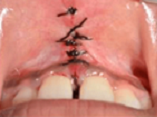A Comparative Study of The Results of Conventional Surgery and Diode Laser in Maxillary Labial Frenectomy: A Randomized Clinical Trial
DOI:
https://doi.org/10.31661/gmj.v13iSP1.3688Keywords:
Conventional Surgery; Diode Laser; Maxillary Labial FrenectomyAbstract
Background: The frenum, a flexible tissue structure connecting the lips, tongue, and cheeks to the gingiva, can exhibit abnormalities leading to dental complications such as diastema and restricted movement. This study investigates the efficacy and safety of frenectomy by diode laser, compared to traditional surgical approaches. Materials and Methods: This clinical trial, approved by the ethical committee and registered with the Iranian Registry of Clinical Trials (IRCT20231009059673N1), enrolled 26 patients requiring maxillary labial frenectomy due to papillary or penetrating frenum types who had referred to specialized periodontics department of Jundishapur Dental School of Ahvaz in 2023-2024. Participants were randomly assigned to either a conventional surgical method or the frenectomy by diode laser (Quicklase laser, UK). Surgical procedures were standardized, and various outcome measures—including surgery duration, pain assessment, surgical difficulty, bleeding intensity, swelling, and tissue repair were evaluated and compared among groups. Results: This study evaluated the outcomes of maxillary labial frenectomy using laser versus conventional methods in 26 participants (19 women, 7 men). Significant differences were found in surgery duration (laser: 341.46 seconds vs. conventional: 675.00 seconds, P < 0.001) and pain levels, with the laser group reporting lower pain on Days One (3.53 vs. 6.00, P < 0.001) and Seven (0.46 vs. 1.38, P = 0.002). The laser group also experienced less bleeding and swelling, higher healing scores at one week (3.92 vs. 2.61, P < 0.001), and required fewer analgesics (5.53 vs. 9.76, P < 0.001), demonstrating superior outcomes with laser treatment. Conclusion: In conclusion, the England Quicklase laser method demonstrates significant advantages over conventional frenectomy techniques, including shorter surgery duration, reduced pain and bleeding, improved healing, and lower analgesic use. These findings support the laser's potential as a preferred option for maxillary labial frenectomy, enhancing patient care.
References
Patel R, Varma S, Suragimath G, Abbayya K, Zope S, Kale V. Comparison of labial frenectomy procedure with conventional surgical technique and diode laser. J Dent Lasers. 2015;9(2):94.
https://doi.org/10.4103/0976-2868.170565
Indurkar MS, Thakur K. Comparison of labial frenectomy by conventional surgical technique versus diode laser. International Journal of Medical Science and Current Research. 2020;3(4):153.
Xie L, Wang P, Ding Y, Zhang L. Comparative frenectomy with conventional scalpel and dual-waved laser in labial frenulum. World Journal of Pediatric Surgery. 2022 Jan 11;5(1):e000363.
https://doi.org/10.1136/wjps-2021-000363
PMid:36474628 PMCid:PMC9716829
Calisir M, Ege B. Evaluation of Patient Perceptions after Frenectomy Operations: A Comparison of Neodymium‑Doped Yttrium Aluminum Garnet Laser and Conventional Techniques in the Same Patients. Nigerian journal of clinical practice. 2018;21(8):1059-64.
https://doi.org/10.4103/njcp.njcp_2_18
PMid:30074011
Gujjari SK, Shubhashini P. Frenectomy: a review with the reports of surgical techniques. Journal of clinical and diagnostic research: JCDR. 2012;6(9):1587.
Mirko P, Miroslav S, Lubor M. Significance of the labial frenum attachment in periodontal disease in man Part 1 Classification and epidemiology of the labial frenum attachment. Journal of periodontology. 1974 Dec;45(12):891-4.
https://doi.org/10.1902/jop.1974.45.12.891
PMid:4533498
Yadav RK, Verma UP, Sajjanhar I, Tiwari R. Frenectomy with conventional scalpel and Nd: YAG laser technique: A comparative evaluation. Journal of Indian Society of Periodontology. 2019;23(1):48-52.
https://doi.org/10.4103/jisp.jisp_352_18
PMid:30692743 PMCid:PMC6334537
Sarmadi R, Gabre P, Thor A. Evaluation of upper labial frenectomy: A randomized, controlled comparative study of conventional scalpel technique and Er: YAG laser technique. Clinical and experimental dental research. 2021;7(4):522-30.
https://doi.org/10.1002/cre2.374
PMid:33369213 PMCid:PMC8404491
Butchibabu K, Koppolu P, Mishra A, Pandey R, Swapna LA, Uppada UK. Evaluation of patient perceptions after labial frenectomy procedure: A comparison of diode laser and scalpel techniques. European Journal of General Dentistry. 2014;3(02):129-33.
https://doi.org/10.4103/2278-9626.134839
Raz H, Jalili Sadrabad M, Labibzadeh A, Mostakhdemin Hoseini L, Ghorbani R. Comparison of Complications and Patients' Satisfaction in labial Frenectomy by using Diode laser versus Surgical technique- Blind Clinical Trial. Laser in Medicine. 2021;18(1):23-31.
Azma E, Safavi N. Diode laser application in soft tissue oral surgery. Journal of lasers in medical sciences. 2013;4(4):206.
Protásio ACR, Galvão EL, Falci SGM. Laser techniques or scalpel incision for labial frenectomy: a meta-analysis. Journal of maxillofacial and oral surgery. 2019;18:490-9.
https://doi.org/10.1007/s12663-019-01196-y
PMid:31624426 PMCid:PMC6795652
Ize-Iyamu I, Saheeb B, Edetanlen B. Comparing the 810nm diode laser with conventional surgery in orthodontic soft tissue procedures. Ghana medical journal. 2013;47(3):107-11.
ES M, AM AE-b, OM S, HG H. Low level diode laser therapy on wound healing post gingivectomy. Journal of Life Science and Biomedicine. 2020;10(06):80-6.
https://doi.org/10.51145/jlsb.2020.10
Lebret C, Garot E, Pereira MA, Fricain J-C, Catros S, Fénelon M. Perioperative outcomes of frenectomy using laser versus conventional surgery: a systematic review. Journal of Oral Medicine and Oral Surgery. 2021;27(3):36.
https://doi.org/10.1051/mbcb/2021010
Dioguardi M, Ballini A, Quarta C, Caroprese M, Maci M, Spirito F, et al. Labial frenectomy using laser: a scoping review. International Journal of Dentistry. 2023;2023(1):7321735.
https://doi.org/10.1155/2023/7321735
PMid:37168276 PMCid:PMC10164919
Sobouti F, Moallem Savasari A, Aryana M, Hakimiha N, Dadgar S. Maxillary labial frenectomy: a randomized, controlled comparative study of two blue (445 nm) and infrared (980 nm) diode lasers versus surgical scalpel. BMC Oral Health. 2024;24(1):843.
https://doi.org/10.1186/s12903-024-04364-w
PMid:39054510 PMCid:PMC11271033
Paleriya K, Patil R, Dhadse P, Salian S, Punse S, Rai A. Maxillary Labial Double Frenum Frenectomy Using a Diode Laser: A Case Report. Cureus. 2024 Jun 28;16(6):e63400.
https://doi.org/10.7759/cureus.63400
Bianchi N, Lorenzi C, Pinto A, Laureti A, Carosi P. Upper-lip laser frenectomy with a diode laser in a pediatric patient a case report. Journal of Biological Regulators and Homeostatic Agents. 2021 May 1;35:29-35.
https://doi.org/10.23812/21-3supp1-5
PMid:34289662
Öztürk Özener H, Meseli SE, Sezgin G, Kuru L. Clinical efficacy of conventional and diode laser-assisted frenectomy in patients with different abnormal frenulum insertions: a retrospective study. Photobiomodulation, Photomedicine, and Laser Surgery. 2020 Sep 1;38(9):565-70.
https://doi.org/10.1089/photob.2020.4841
PMid:32833580

Published
How to Cite
Issue
Section
License
Copyright (c) 2024 Galen Medical Journal

This work is licensed under a Creative Commons Attribution 4.0 International License.







